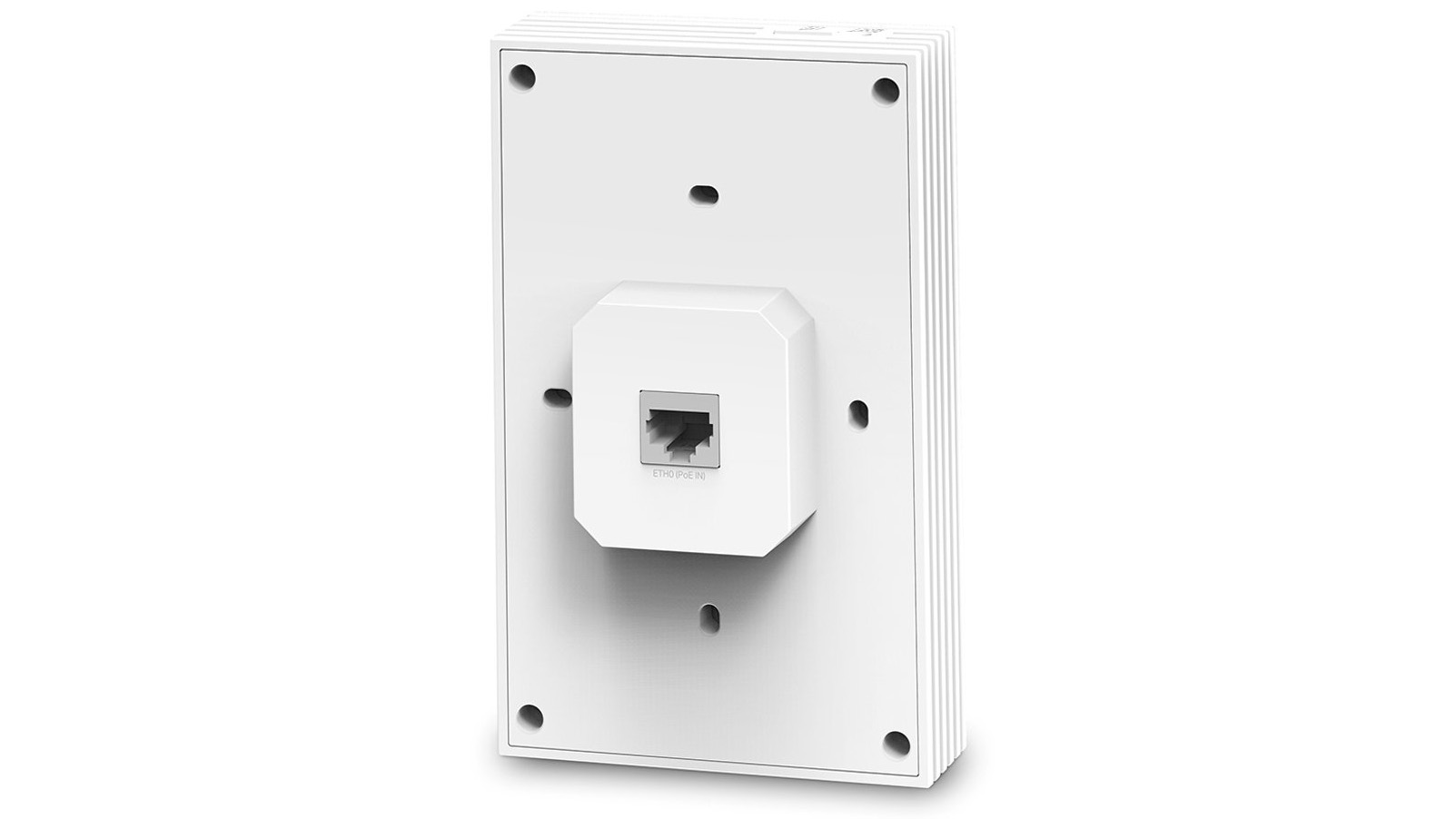TP-Link Omada EAP655-Wall review: A reasonably fast Wi-Fi 6 AP with a good range
The TP-Link Omada EAP655 is an affordable wall-mount Wi-Fi 6 AP with good speed, triple gigabit download ports, and great cloud management

-
+
Fast performance
-
+
Affordable
- +
-
-
No 2.5GbE port

TP-Link's EAP655-Wall is designed to offer discrete Wi-Fi 6 services to a wide range of environments, such as meeting rooms, apartments and home offices. This affordable palm-sized package will also appeal to hotels looking to provide in-room network services as it has three gigabit ports in its base and can deliver PoE on the third one – ideal for adding extra room devices such as IP phones.
For more on Wi-Fi 6 routers checkout our Best Wi-Fi routers and access points 2023
The EAP655-Wall offers plenty of features for the price. This AX3000 dual-band access point (AP) delivers speeds of up to 2,402Mbits/sec on its 5GHz radio and 574Mbits/sec on the 2.4GHz radio. It also supports the high-speed Wi-Fi 6 160MHz channels, although the AP's main uplink port is only the gigabit variety so you won't see their full potential.
TP-Link Omada EAP655-Wall review: Performance
The EAP655-Wall delivered good overall results in our real-world performance tests. We started with its 80MHz channels enabled. Close-range copies of a large file between a Dell Windows 11 Pro workstation equipped with a TP-Link Archer TXE75E Wi-Fi 6E PCI-E card and a server on our 10GbE LAN averaged 94MB/sec, dropping to 77MB/sec with the AP moved ten metres away and into an adjoining room.
With the AP's 160MHz channels activated, the workstation reported a 2.4Gbits/sec wireless connection. Unsurprisingly, our file copies maxed out the AP's gigabit port and only increased to 111MB/sec at close range and 91MB/sec at ten metres, although these speeds will easily be good enough for all but the most demanding of users.
The AP can be managed in standalone mode, but most businesses will prefer TP-Link's Omada cloud service as they can manage all their APs from one central web portal. Previously, each site required a hardware or software controller installed locally, but TP-Link now also offers cloud-based controllers with yearly prices starting at £12 per device.
From our main Omada cloud portal account, we viewed all our hardware, software and cloud-based controllers, and selecting the latter took us to its dedicated management console. Before adding the AP to our site, we made sure we'd enabled the cloud-based controller management option from its local web console. We could then import the AP by entering its serial number, naming it and assigning a licence. After adoption, access to its local console was disabled and it started broadcasting our site-managed SSIDs.
The site portal presents a detailed dashboard that can be customised with widgets; we added ones to show details such as AP traffic and client distributions, the most active APs, a Wi-Fi summary and 24-hour graphs of client associations and overall wireless traffic. The AP was connected to the lab's TP-Link TL-SG3210XHP-M2 PoE+ multi-gigabit switch, and we added more widgets to show its active ports, PoE usage and the available power budget.

Wireless features are extensive, with up to eight SSIDs per radio supported and options to apply mixed WPA2/WPA3 encryption. You can set global or per-client and SSID upload and download rate limits, and use guest networks to block users from private networks.
Captive portal features are equally good, with profiles used to apply a global password, local user, voucher, Radius or Facebook authentication and add logos, greeting messages and acceptable use policies.
The three gigabit pass-through ports are enabled by default, and PoE services on the third port can be activated by checking this option in the portal's AP configuration page, although make sure the main LAN port is connected to a PoE+ source. During testing, they worked fine and after connecting a Yealink IP phone to the third port, it duly received power and internet access.
It would have been good to see a 2.5GbE port, but the EAP655-Wall remains a reasonably fast Wi-Fi 6 AP with a good range. It offers a wealth of wireless features for a modest price, cloud management is excellent and its three gigabit downlink ports with extra power delivery make it even more versatile.
TP-Link Omada EAP655-Wall specifications
| Band support | AX3000 dual-band 2.4GHz/5GHz 802.11ax AP |
| Radios | 2 x dual-band internal aerials |
| Dimensions (WHD) | 86x43x143mm |
| Weight | 300g |
| Warranty | Limited lifetime warranty |
Get the ITPro daily newsletter
Sign up today and you will receive a free copy of our Future Focus 2025 report - the leading guidance on AI, cybersecurity and other IT challenges as per 700+ senior executives
Dave is an IT consultant and freelance journalist specialising in hands-on reviews of computer networking products covering all market sectors from small businesses to enterprises. Founder of Binary Testing Ltd – the UK’s premier independent network testing laboratory - Dave has over 45 years of experience in the IT industry.
Dave has produced many thousands of in-depth business networking product reviews from his lab which have been reproduced globally. Writing for ITPro and its sister title, PC Pro, he covers all areas of business IT infrastructure, including servers, storage, network security, data protection, cloud, infrastructure and services.
-
 Cleo attack victim list grows as Hertz confirms customer data stolen – and security experts say it won't be the last
Cleo attack victim list grows as Hertz confirms customer data stolen – and security experts say it won't be the lastNews Hertz has confirmed it suffered a data breach as a result of the Cleo zero-day vulnerability in late 2024, with the car rental giant warning that customer data was stolen.
By Ross Kelly Published
-
 Women show more team spirit when it comes to cybersecurity, yet they're still missing out on opportunities
Women show more team spirit when it comes to cybersecurity, yet they're still missing out on opportunitiesNews While they're more likely to believe that responsibility should be shared, women are less likely to get the necessary training
By Emma Woollacott Published
-
 OpenAI wants developers using its new GPT-4.1 models – but how do they compare to Claude and Gemini on coding tasks?
OpenAI wants developers using its new GPT-4.1 models – but how do they compare to Claude and Gemini on coding tasks?News OpenAI says its GPT-4.1 model family offers sizable improvements for coding, but tests show competitors still outperform it in key areas.
By Ross Kelly Published